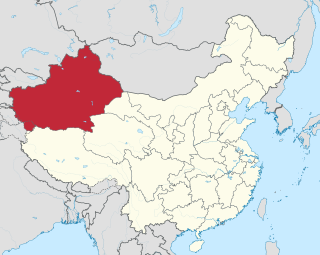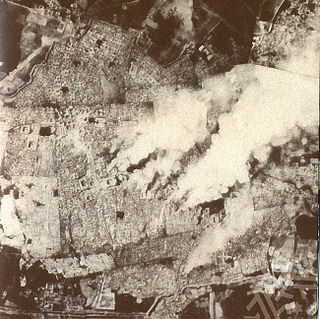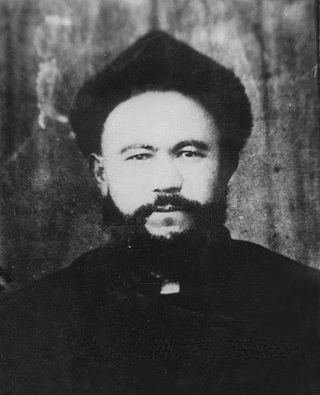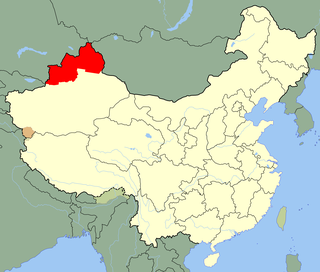Turkestan, also spelled Turkistan, is a historical region in Central Asia corresponding to the regions of Transoxiana and Xinjiang.

East Turkestan is a loosely defined geographical and historical region in the western provinces of the People's Republic of China, which varies in meaning by context and usage. The term was coined in the 19th century by Russian Turkologists, including Nikita Bichurin, who intended the name to replace the common Western term for the region, Chinese Turkestan, which referred to the Tarim Basin in the southwestern part of Xinjiang during the Qing dynasty. Beginning in the 17th century, Altishahr, which means "Six Cities" in Uyghur, became the Uyghur name for the Tarim Basin. Uyghurs also called the Tarim Basin "Yettishar," which means "Seven Cities," and even "Sekkizshahr", which means "Eight Cities" in Uyghur. Chinese dynasties from the Han dynasty to the Tang dynasty had called an overlapping area the "Western Regions". The parts of this area conquered by the Manchu Qing dynasty were termed "Xinjiang" from the 18th century on.

The Basmachi movement was an uprising against Russian Imperial and Soviet rule in Central Asia by rebel groups inspired by Islamic beliefs.

Russian Turkestan was the western part of Turkestan within the Russian Empire’s Central Asian territories, and was administered as a Krai or Governor-Generalship. It comprised the oasis region to the south of the Kazakh Steppe, but not the protectorates of the Emirate of Bukhara and the Khanate of Khiva.

Turkistan is a city and the administrative center of Turkistan Region of Kazakhstan, near the Syr Darya river. It is situated 160 km (100 mi) north-west of Shymkent on the Trans-Aral Railway between Kyzylorda to the north and Tashkent to the south. Its population has increased in ten years from 102,505 to 142,899. Turkistan's most prominent historical and cultural asset is the Mausoleum of Khoja Ahmed Yasawi, a UNESCO World Heritage site. The city is served by Hazrat Sultan International Airport.

The Turkic Islamic Republic of East Turkestan (TIRET) was a short-lived breakaway Islamic republic founded on 12 November 1933. It was centred on the city of Kashgar in West of Xinjiang province (1912–1992) in what is today a part of Xinjiang Uyghur Autonomous Region. Sometimes referred to simply as the East Turkestan Republic (ETR), it was primarily the product of an independence movement of the Uyghur population living there and more broadly of Turkic-ethnicity in character, including Kyrgyz and other Turkic peoples in its government and its population.

The East Turkestan independence movement is a political movement that seeks the independence of East Turkestan, a large and sparsely-populated region in northwest China, as a nation state for the Uyghur people. The region is currently administered as a province-level subdivision of the People's Republic of China (PRC), under the official name Xinjiang Uygur Autonomous Region (XUAR). Within the movement, there is widespread support for the region to be renamed, since "Xinjiang" is seen by independence activists as a colonial name. "East Turkestan" is the best-known proposed name as it is the historical geographic name of the region and the name of the two independent states that briefly existed in the region in the first half of the 20th century.

The East Turkestan Republic (ETR) was a short-lived satellite state in northwest Xinjiang, between November 12, 1944, and December 22, 1949. To differentiate it from the First East Turkestan Republic (1933–1934) it is often described as the SecondEast Turkestan Republic, although the adjective Second was never an official part of its name.

Soviet Central Asia was the part of Central Asia administered by the Soviet Union between 1918 and 1991, when the Central Asian republics declared independence. It is nearly synonymous with Russian Turkestan in the Russian Empire. Soviet Central Asia went through many territorial divisions before the current borders were created in the 1920s and 1930s.

Sabit Damolla was a Uyghur independence movement leader who led the Hotan rebellion against the Xinjiang Province government of Jin Shuren and later the Uyghur leader Khoja Niyaz. He is widely known as the first and only prime minister of the short-lived Islamic Republic of East Turkestan from November 12, 1933, until the republic's defeat in May 1934.

The Alash Autonomy, also known as Alash Orda was a Kazakh provisional government, or proto-state, located mainly in Central Asia, and partly in Eastern Europe. It was part of the Russian Republic, and then Soviet Russia. The Alash Autonomy was founded in 1917 by Kazakh elites, and disestablished after the Bolsheviks banned the ruling Alash party. The goal of the party was to obtain autonomy within Russia, and to form a national, democratic state. The political entity bordered Russian territories to the north and west, the Turkestan Autonomy to the south, and China to the east.

Xinjiang, alternatively romanized as Sinkiang, is an area located in Central Asia, between 73 ° 5 'to 96 ° 4' east and 35 ° 5 'and 49 ° north, in total 1,660,000 square km, sharing borders with Mongolia, Russia, Kazakhstan, Kyrgyzstan, Tajikistan, Afghanistan, India, Pakistan and China's Tibet Autonomous Region, Qinghai Province and Gansu Province. This region has been called Western Regions in China's history and is currently known as China's Xinjiang Uyghur Autonomous Region, a provincial-level jurisdiction.
The incorporation of Xinjiang into the People's Republic of China in 1949, known in Chinese historiography as the Peaceful Liberation of Xinjiang, was the takeover of the Republic of China's Xinjiang Province by the Chinese Communist Party (CCP) and its People's Liberation Army, largely through political means, in the waning days of the Chinese Civil War.

The Ili Rebellion was a Uyghur separatist movement backed by the Soviet Union against the Kuomintang government of the Republic of China in 1944. After the start of the rebellion, the rebels established the Provisional Government of the Second East Turkestan Republic in 1944. The Ili Rebellion was the start of the East Turkistan National Liberation Revolution, also known as the Three Districts Revolution, which lasted from 1944 to 1949.

The Syr-Darya Oblast was one of the oblasts of the Russian Empire, a part of Russian Turkestan. Its center was Tashkent.

‑stan has the meaning of "a place abounding in" or "a place where anything abounds" as a suffix. It originated in the Persian language, but is widely used by other Iranic languages as well as the Shaz Turkic languages and other languages historically influenced by Persian. The suffix appears in the names of many regions throughout West, Central and South Asia, and parts of the Caucasus and Russia.

Reichskommissariat Turkestan was a projected Reichskommissariat that Germany proposed to create in Russia and the Central Asian republics of the Soviet Union in its military conflict with that country during World War II. Soviet historian Lev Bezymenski claimed that names Panturkestan, Großturkestan and Mohammed-Reich were also considered for the territory.

The Semirechyenskaya Oblast was an oblast (province) of the Russian Empire. It corresponded approximately to most of present-day southeastern Kazakhstan and northeastern Kyrgyzstan. It was created out of the territories of the northern part of the Khanate of Kokand that had been part of the Kazakh Khanate. The name "Semirechye" itself is the direct Russian translation of the historical region of Jetysu. Its site of government was Verniy.

Xinjiang Province or Sinkiang Province was a province of the Republic of China. First set up as a province in 1884 by the Qing dynasty, it was replaced in 1955 by the Xinjiang Uygur Autonomous Region of the People's Republic of China. The original provincial government was relocated to Taipei as the Sinkiang Provincial Government Office (新疆省政府辦事處) until its dissolution in 1992.

The Turkestan Autonomy or Kokand Autonomy was a short-lived state in Central Asia that existed at the beginning of the Russian Civil War. It was formed on 27 November 1917 and existed until 22 February 1918. It was a secular republic, headed by a president.
















